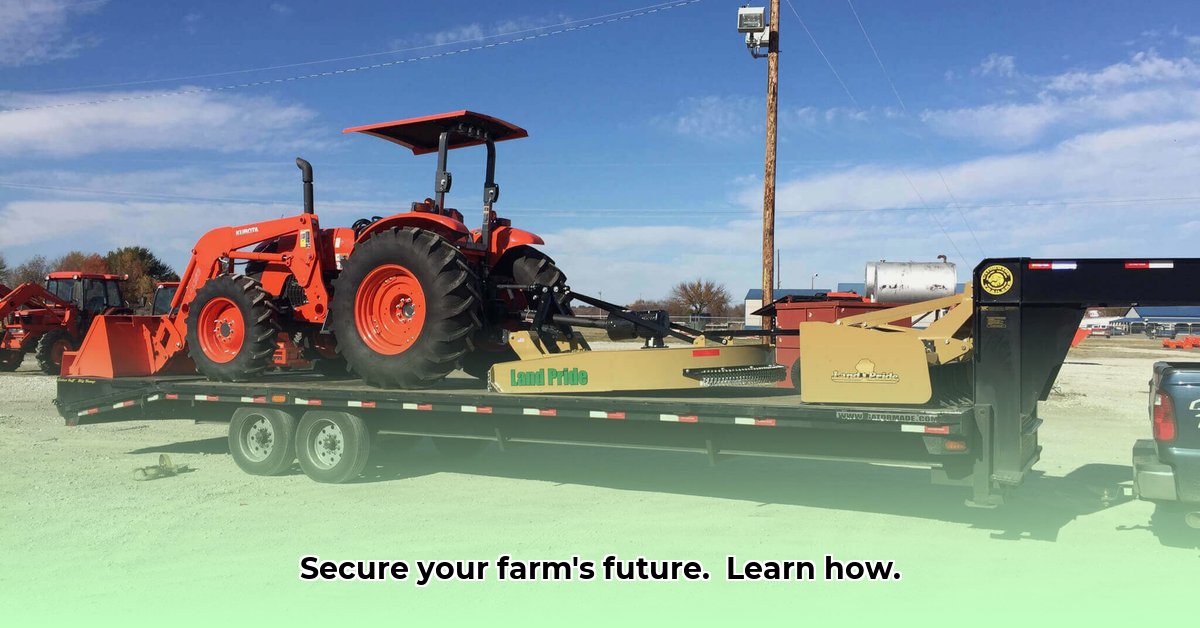
Efficient and safe tractor transport is critical for modern, sustainable agriculture. Downtime translates directly to lost revenue, so choosing the right hauling service, and employing sustainable practices, is paramount. For more detailed information on tractor shipping, check out this helpful guide: Learn More. This guide will equip farmers, ranchers, and industry professionals with the knowledge and actionable steps needed for successful and environmentally conscious tractor hauling.
Choosing the Right Tractor Hauling Service: Prioritizing Safety and Sustainability
Selecting a hauling service isn't just about price; it's about finding a reliable partner who understands the unique demands of transporting heavy agricultural machinery. Consider these factors:
Experience: Look for a company with a demonstrated history of successfully hauling large agricultural equipment. Years of experience handling oversized loads minimizes risk and ensures efficient transport. Request references and check online reviews.
Specialized Equipment: Ensure they utilize trailers and equipment specifically designed to secure your tractor safely and prevent damage. Inquire about their securing procedures and request photographic evidence of previous hauls.
Safety Record: Thoroughly investigate their safety record, including accident history and insurance coverage. A strong safety record demonstrates commitment to responsible operations, reducing risk to your investment.
Insurance: Adequate insurance coverage protects you from potential financial losses in case of accidents or damage. Confirm sufficient liability insurance to cover the full replacement value of your tractor.
Service Options: Inquire whether they provide door-to-door service, eliminating the need for additional transportation and saving valuable time.
Permits and Regulations: Ensure they handle all necessary permits and paperwork, preventing potential delays and fines. Their familiarity with local and state regulations is crucial for efficient transport.
Minimizing Risks: Protecting Your Valuable Investment
While complete risk elimination is impossible, proactive measures significantly reduce the chances of damage or delays.
1. Damage Prevention:
Securement: Proper securing of the tractor on the trailer is non-negotiable. Clarify their securing methods and request photos to verify the process.
Insurance: Comprehensive insurance coverage is your crucial safety net, protecting against financial losses due to accidents or damage.
Reputation: Choose a reputable carrier with a proven track record of safe and reliable service. Word-of-mouth recommendations often indicate a trustworthy operator.
2. Regulatory Compliance:
Permits and Licenses: Staying updated on permits and documentation prevents delays and fines. Regulations vary by location; confirm your hauler understands and adheres to all relevant rules.
Continuous Monitoring: Regularly check for updates in transportation regulations. Rules evolve; staying informed ensures compliance.
3. Fuel Efficiency and Environmental Impact:
Eco-Friendly Practices: Select companies prioritizing fuel-efficient practices and environmentally conscious transportation. This reduces your carbon footprint and aligns with sustainable farming goals. Inquire about their use of alternative fuels like biodiesel.
Route Optimization: Efficient routes minimize fuel consumption and emissions. Advanced route planning tools are key for this.
4. Driver Shortages: Establish strong relationships with reliable carriers to guarantee availability, especially during peak seasons. The cost of delays significantly outweighs the potential premium for reliable service.
Long-Term Strategies: Optimizing Tractor Hauling for Profitability and Sustainability
Long-term planning optimizes costs and efficiency while promoting sustainability.
Volume Discounts: Negotiate volume discounts for regular transport, significantly reducing costs over time.
Alternative Fuels: Support carriers using sustainable alternatives like biodiesel or compressed natural gas (CNG), reducing your environmental impact.
Cost Tracking: Maintain detailed records of transportation expenses to identify cost-saving opportunities and monitor trends.
Technology: Employ GPS tracking and data analytics for real-time visibility into tractor location and status, improving efficiency and response time in emergencies.
Weighing the Costs and Benefits: A Balanced Perspective
While tractor hauling incurs expenses, the benefits strongly outweigh the costs. Reliable transport minimizes downtime, directly impacting productivity and profitability. The financial impact of equipment damage or delays far exceeds the cost of a quality hauling service.
The Role of Regulators: Ensuring Safety and Environmental Protection
Government agencies play a critical role in overseeing tractor transport, setting standards for safety, environmental protection, and driver training. They enforce compliance, ensuring the safety of all stakeholders and protecting the environment. Their involvement ensures responsible and sustainable practices within the industry.
Actionable Steps for All Stakeholders
This table summarizes actionable steps for different stakeholders:
| Stakeholder | Short-Term Actions | Long-Term Actions |
|---|---|---|
| Farmers/Ranchers | Obtain multiple quotes; compare services; verify insurance. | Negotiate bulk rates; prioritize sustainable transport; track expenses. |
| Hauling Companies | Improve online presence; add customer testimonials; highlight safety. | Invest in route optimization software; expand service areas; explore alternative fuels. |
| Agribusinesses | Optimize logistics; analyze transport costs; pursue efficiency gains. | Collaborate on bulk shipments; adopt sustainable supply chain practices. |
| Regulators | Enforce safety standards; ensure permit compliance; monitor emission levels. | Develop updated regulations for oversized loads; encourage sustainable practices. |
Efficient and sustainable tractor transport is crucial for the future of agriculture. By implementing these strategies and staying informed, farmers can ensure their operations remain productive and environmentally responsible.